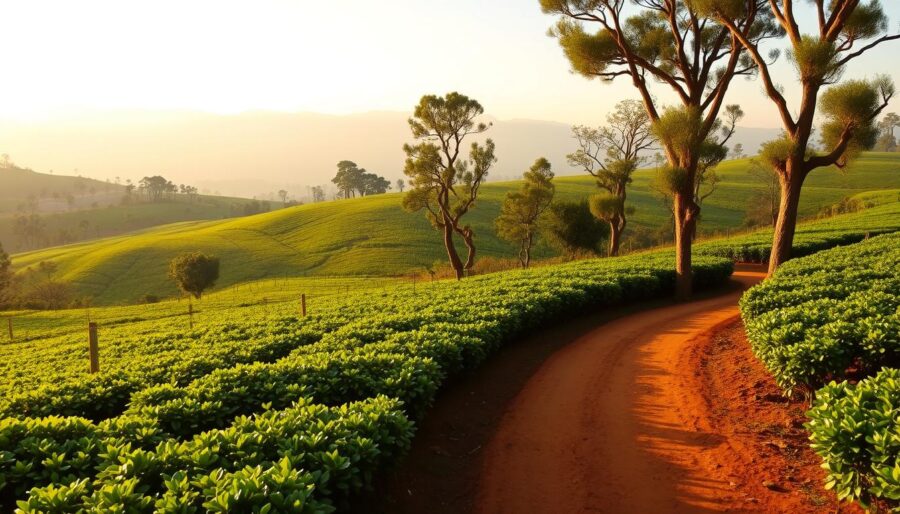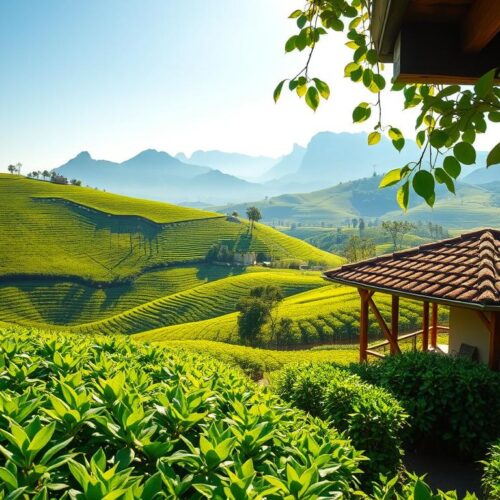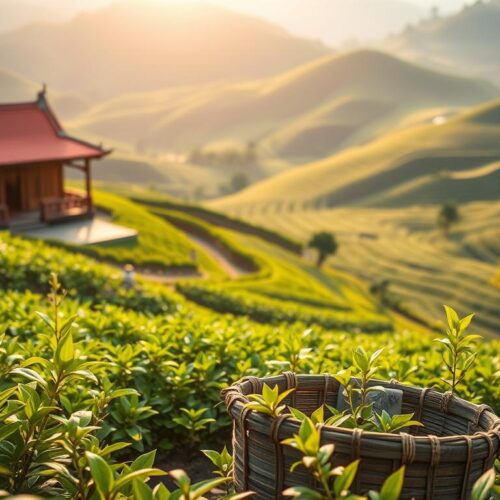Start an amazing tea tour in Kenya and dive into the world of Kenya tea. Kericho, known for its green landscapes and lively culture, is the heart of the tea industry in Kenya. You will explore the deep history and special tastes of this area.
This guide takes you on an exciting journey from planting to brewing, highlighting African tea’s significance and the green practices that keep the industry alive. For those passionate about tea or seeking a unique trip, Kenya’s tea regions provide a memorable link to nature and history.
Discover the Rich History of Kenyan Tea
Kenya’s tea history began in the early 20th century, influenced by British colonialism. Tea farms started in places like Kericho, changing the region and starting a successful tea sector. These farms made Kenya a leading exporter of black tea, loved around the world.
Local tribes greatly influenced Kenyan tea farming practices. They passed down traditional growing methods, giving the tea its distinct tastes. This blend of local knowledge highlights Kenya’s culture and adds to the global tea industry.
On a Kenya tea tour, you’ll see beautiful tea-covered hills and learn about its culture-rich history. Knowing the history of Kenya tea makes your visit more meaningful and lets you appreciate tea making more.
| Year | Event | Significance |
|---|---|---|
| 1903 | First tea seedlings planted | Marking the beginning of the tea industry in Kenya |
| 1920 | Establishment of large tea estates | Kericho becomes a major tea producing area |
| 1963 | Kenya gains independence | Shift toward local ownership and practices |
| 2000s | Global demand increases | Kenya solidifies its position as a top exporter of black tea |
The Unique Geography of Kenya’s Tea Plantations
The geography of Kenya’s tea areas is a fascinating blend. This region is ideal for tea growth. The high altitudes and rich volcanic soil in Kericho create perfect tea conditions. This results in tea with great flavor and aroma.
Rainfall and temperature are key in making Kenyan tea special. The right amount of rain and mild weather helps tea grow well. Here, you’ll find rich varieties of black and green teas, each with its own flavor.
Kenya’s varied geography plays a big role in its famous tea industry. Every area brings something unique to the tea it produces. This lets drinkers enjoy many different flavors and textures. Whether you’re new to tea or know it well, learning about these places makes loving Kenya’s teas even more.
Understanding Different Types of Kenyan Tea
Kenya is famous for making different kinds of tea, catering to a variety of tastes. Black tea is the most well-known, making up the bulk of Kenya’s tea exports. It has a strong flavor and dark color, usually enjoyed plain or with milk or sugar.
Green tea has also become popular in Kenya, thanks to global influences. It’s less processed than black tea, keeping its light taste. Black and green teas have unique flavors because of how they’re made, appealing to various people.
Besides black and green teas, Kenya also has flavored and herbal teas. Each one has its own special taste, influenced by Kenya’s climate, altitude, and soil. Knowing these differences can make your tea tour more enjoyable, helping you find your favorite.
If you’re looking into tea, try talking to local producers. They can tell you about traditional ways of making tea and how that affects taste. This info can help you feel a deeper connection to Kenyan tea culture and its history.
The Harvesting Process: From Leaf to Production
The journey from the green gardens of Kenya to your cup starts with harvesting tea. Workers pick young leaves with care. They choose only the finest ones for quality.
Modern machines also help with tea harvesting in Kenya, improving output in big farms. This mix of old ways and new technology keeps the tea’s quality high. After picking, the leaves are processed through stages such as withering, rolling, fermenting, and drying. Each step is key to bringing out the tea’s unique taste and smell.
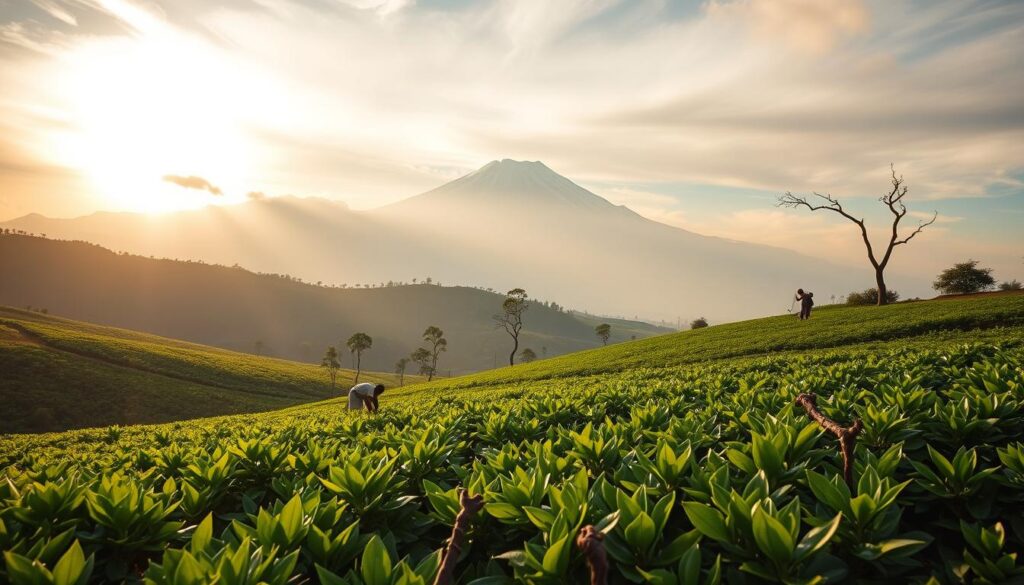
Doing things at the right time and in the right way is important in making tea. These methods greatly affect the tea’s quality. Knowing how tea is made lets tea lovers understand the effort behind their drink. Every sip shows the hard work of those behind this famous tradition.
Eco-Friendly Practices in Tea Farming
In Kenya, tea farmers are now focusing more on sustainable farming. They use fewer chemicals and more natural methods to keep the soil healthy. This way, they protect the environment and produce better tea.
The TEAFAM project is a great example of their efforts. It teaches people about healthy eating and how to grow food in kitchen gardens. This helps farmers grow more than just tea. It makes sure they have enough to eat and keeps farming practices green.
Kenya is leading the way in making tea farming more eco-friendly. This change is not just good for Kenya but sets an example for the world. As more people choose tea made this way, it encourages farmers everywhere to farm with the planet in mind.
Planning Your Tea Tour in Kenya
Planning your tea tour in Kenya is an exciting adventure. You’ll discover lush landscapes and rich flavors. The best time to go is from March to September. This is when the weather is great for tea harvesting. It’s also when you can see the cultivation process and enjoy mild temperatures.
For Kericho tours, visit famous tea estates like Kericho Tea Plantations and Changoi Estates. These places make high-quality tea and offer guided tours. A visit will give you a deep dive into Kenyan tea culture. It promises to be an unforgettable journey.
Getting around the region is easy. You can rent a car, take local buses, or get a guide. A guide can make your trip smoother. They also tell you about tea’s cultural importance in Kenya. This knowledge adds to your tour.
There are many places to stay near the tea plantations. You can find luxury lodges or budget-friendly guesthouses. Consider places like Hotel Gracia Gardens or Kericho Tea Hotel. They are close to the tea estates. It’s smart to book your stay early, especially in the busy months.
Last, learn about local customs to enrich your trip. Talk with tea workers and learn about their lives. It’s important to respect their traditions. This cultural exchange makes your tea tour even more special.
| Aspect | Details |
|---|---|
| Best Time to Visit | March to September |
| Popular Estates | Kericho Tea Plantations, Changoi Estates |
| Transportation Options | Car rental, local buses, guided tours |
| Recommended Accommodations | Hotel Gracia Gardens, Kericho Tea Hotel |
| Cultural Etiquette | Engage respectfully, learn about traditions |
What to Expect on a Tea Tour
A tea tour in Kenya is a fantastic way to learn about tea production. At the famous Kericho tea estates, you will see beautiful, vast green tea fields. These stretches of land are truly a sight to behold.
The tour usually includes walks through the tea fields. Experts there will tell you how tea grows and about the different tea types found there. It’s a great way to understand the effort behind tea farming.
Tasting sessions are a big part of the tour. You get to try different teas, each with its own taste and scent. These unique flavors come from Kericho’s special climate. Trying these teas lets you experience the rich tea culture of Kenya.
You’ll also meet the local farmers during the tour. Talking to them adds a personal touch to your experience. You learn about the community’s tea farming traditions and practices. These interactions help you understand the importance of tea in their lives.
By the end of your journey, you’ll have learned a lot. You’ll take home knowledge and memories that show what Kericho tea estates and Kenyan tea culture are all about.
The Importance of Tea in Kenyan Culture
Tea is key in Kenyan culture. It’s more than just a drink; it symbolizes hospitality and brings people together. Sharing tea means sharing stories and connections at gatherings.
In Kenya, tea is central to many rituals. It shows respect to guests and unites community members. Tea brings people closer, sparking conversations and strengthening bonds.
Farmers take pride in growing tea, seeing it as part of their heritage. They believe tea drinking creates a sense of togetherness. Stories from these farmers highlight tea’s role in community and personal experiences.
Tea deeply influences cultural customs. The table below shows how tea is used in different situations:
| Context | Significance | Common Practices |
|---|---|---|
| Welcoming Guests | Symbol of hospitality | Serve tea with traditional snacks |
| Community Meetings | Fostering unity and collaboration | Group discussions accompanied by tea |
| Ceremonial Events | Expressing respect and value | Formal serving with traditional rituals |
| Daily Life | Creating bonds within families | Regularly sharing tea during meals |
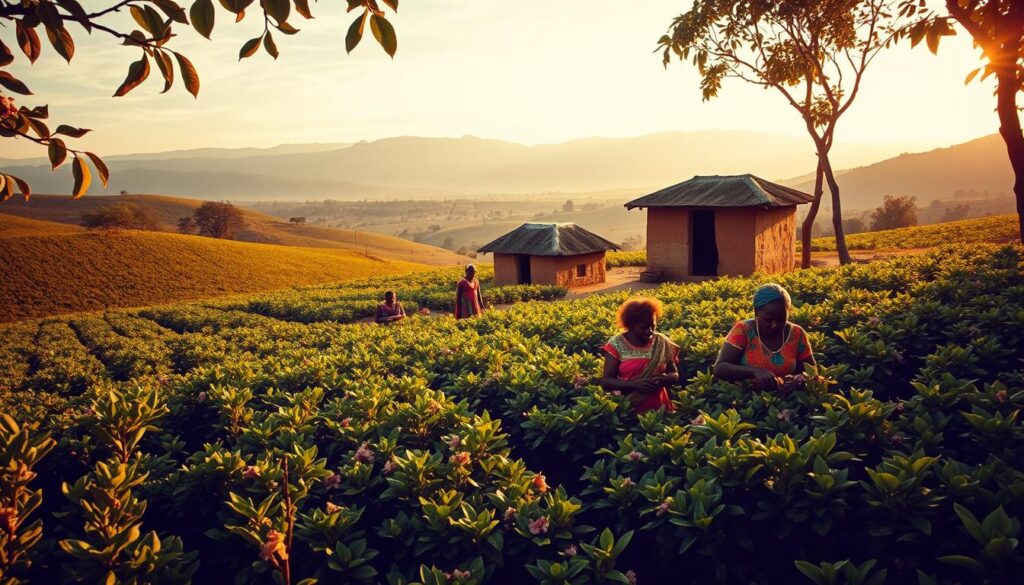
Tasting Kenyan Tea: A Sensory Experience
Tasting Kenyan tea is a delightful journey through its unique flavors. It lets you explore different aromas, colors, and tastes. This experience takes you to Kenyan tea fields in your mind, making you love this drink more.
For an at-home Kenyan tea tasting, get various teas ready. Focus on their processing methods and where they come from. Here’s how to make the most of it:
- Select a variety of Kenyan teas: Consider options such as black, green, and white teas.
- Use clear glassware: This allows you to observe the beautiful colors of each tea.
- Pay attention to aroma: Take time to inhale the fragrance before tasting.
- Take small sips: Allow the flavors to unfold on your palate.
- Pair with local delicacies: Enjoy traditional snacks or pastries to enhance the tasting experience.
By attentively tasting, you’ll uncover the bold and vibrant flavors of Kenyan teas. You’ll notice subtle floral notes and deep earthy tones. This active tasting builds a closer bond to the tea’s culture and the skill in each cup.
Where to Buy Authentic Kenyan Tea
Want to explore Kenya tea? Buying authentic Kenyan tea can make you appreciate this delightful drink more. In local markets in Kenya, you can discover many genuine tea brands. Talking to vendors lets you try various kinds, helping you choose the right flavor for you. Brands like Kericho Gold and Lipton are big names in Kenya, offering a wide range of teas.
If online shopping is more your style, lots of trusted stores sell quality Kenyan tea. Websites such as Amazon and special tea sellers have a good selection of genuine brands. This way, you get the comfort of getting your tea delivered at home. Plus, you make sure it’s the real deal from Kenya. Nowadays, people are keen on buying ethically. So, when you choose certified teas, you help both the planet and the people in Kenya.
When picking your tea, check for labels that show it’s fair trade and organically grown. This is good for the environment. It also means your tea buy is helping the communities that grow these amazing teas.
Exploring the Broader Impact of Tea Tourism
Tea tourism boosts local economies by creating jobs and raising environmental awareness. When you visit, you learn about tea while helping farmers and their communities earn a living. This leads to a type of economic growth that’s good for everyone involved.
Experiencing local traditions and practices offers a rich cultural exchange. You get to really understand Kenya’s tea heritage. Interacting with farmers and artisans builds respect and understanding. These experiences deepen your insight into the local culture, making your trip even richer.
Tea tours help more than just the farms; they boost local businesses too. Shops, transport, and markets get busier when tourists come. The money made can help improve local facilities and fund community projects. This shows how tourism and community welfare are linked together.
| Impact Area | Details |
|---|---|
| Job Creation | Direct employment opportunities in tea farms and related businesses. |
| Cultural Exchange | Interaction with local communities and learning about tea traditions. |
| Economic Benefits | Increased revenue for local businesses and improvements in infrastructure. |
| Environmental Awareness | Promotion of sustainable practices in tea farming among tourists and locals. |
Conclusion: Your Journey Through Kenyan Tea
Exploring Kenyan tea is about more than its worldwide fame. It’s also about the culture in each cup. You’ve seen the area’s rich history and unique land come together. This creates teas with flavors and scents loved all over.
Learning about the eco-friendly ways of farming tea has made the drink even more special. Every sip shows the effort in growing the tea. Plus, it shows the importance of protecting our planet.
Your bond with Kenyan tea culture is now unique to you. It’s an open door to explore tea’s fascinating world more. You might even talk about this discovery with other tea enthusiasts.

